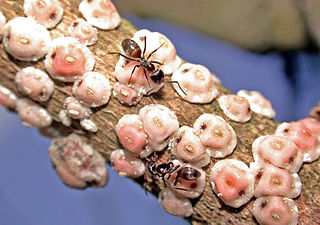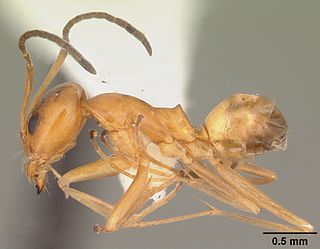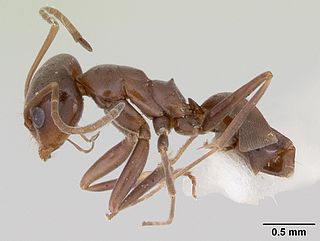
Dorymyrmex is a genus of ants in the subfamily Dolichoderinae.

Florida scrub is a forest ecoregion found throughout Florida in the United States. It is found on coastal and inland sand ridges and is characterized by an evergreen xeromorphic plant community dominated by shrubs and dwarf oaks. Because the low-nutrient sandy soils do not retain moisture, the ecosystem is effectively an arid one. Wildfires infrequently occur in the Florida scrub. Most of the annual rainfall falls in summer.
Dorymyrmex alboniger is a species of ant in the genus Dorymyrmex. Described by Forel in 1914, the species is endemic to Argentina.
Dorymyrmex antarcticus is a species of ant in the genus Dorymyrmex. Described by Forel in 1904, the species is endemic to Argentina and Chile.

Dorymyrmex bossutus is a species of ant in the genus Dorymyrmex. Described by Trager in 1988, the species is endemic to the United States.

Dorymyrmex bureni, also known as the pyramid ant, is a species of ant in the genus Dorymyrmex. Described by Trager in 1988, the species is endemic to the United States and Mexico. Pyramid ants are medium-sized ants, ranging from 2–4 mm. They are light orange in color and fast moving. Unlike other ants in the area like red imported fire ants, this species is not aggressive towards humans. The workers have a foul smelling coconut odor when crushed. Dorymyrmex bureni hunt living insects, even other winged ants. They also search for sap-sucking insects from which they collect honeydew. On the head of these ants are curved hairs, used for transporting beads of damp sand. Colonies are small. Nests usually have a single entrance with a mound of sand shaped like a crater. Dorymyrmex bureni prefer sandy soil. This species of ant is not an indoor pest, and pesticides should not be used. They are found throughout Florida.
Dorymyrmex caretteoides is a species of ant in the genus Dorymyrmex. Described by Forel in 1914, the species is endemic to Argentina.
Dorymyrmex coniculus is a species of ant in the genus Dorymyrmex. Described by Felix Santschi in 1922, the species is endemic to Argentina.
Dorymyrmex emmaericaellus is a species of ant in the genus Dorymyrmex. Described by Kusnezov in 1951, the species is endemic to Bolivia.

Dorymyrmex flavopectus is a species of ant in the genus Dorymyrmex described by Smith in 1944. It is endemic to Florida Scrubs in Florida.
Dorymyrmex fusculus is a species of ant in the genus Dorymyrmex. Described by Santschi in 1922, the species is endemic to Argentina.

Dorymyrmex goeldii is a species of ant in the genus Dorymyrmex. Described by Forel in 1904, the species is endemic to Brazil.

Dorymyrmex jheringi is a species of ant in the genus Dorymyrmex. Described by Forel in 1912, the species is endemic to Brazil and Paraguay.

Dorymyrmex lipan is a species of ant in the genus Dorymyrmex. Described by Snelling in 1995, the species is endemic to the United States and Mexico.
Dorymyrmex pappodes is a species of ant in the genus Dorymyrmex. Described by Snelling in 1975, the species is endemic to Chile.

Dorymyrmex paranensis is a species of ant in the genus Dorymyrmex. Described by Felix Santschi in 1922, the species is endemic to Paraguay.
Dorymyrmex reginicula is a species of ant in the genus Dorymyrmex. Described by Trager in 1988, the species is endemic to the United States.

Dorymyrmex smithi is a species of ant in the genus Dorymyrmex. Described by Cole in 1936, the species is endemic to the United States and Mexico.

Dorymyrmex wheeleri is a species of ant in the genus Dorymyrmex. Described by Kusnezov in 1952, the species is endemic to the United States.











